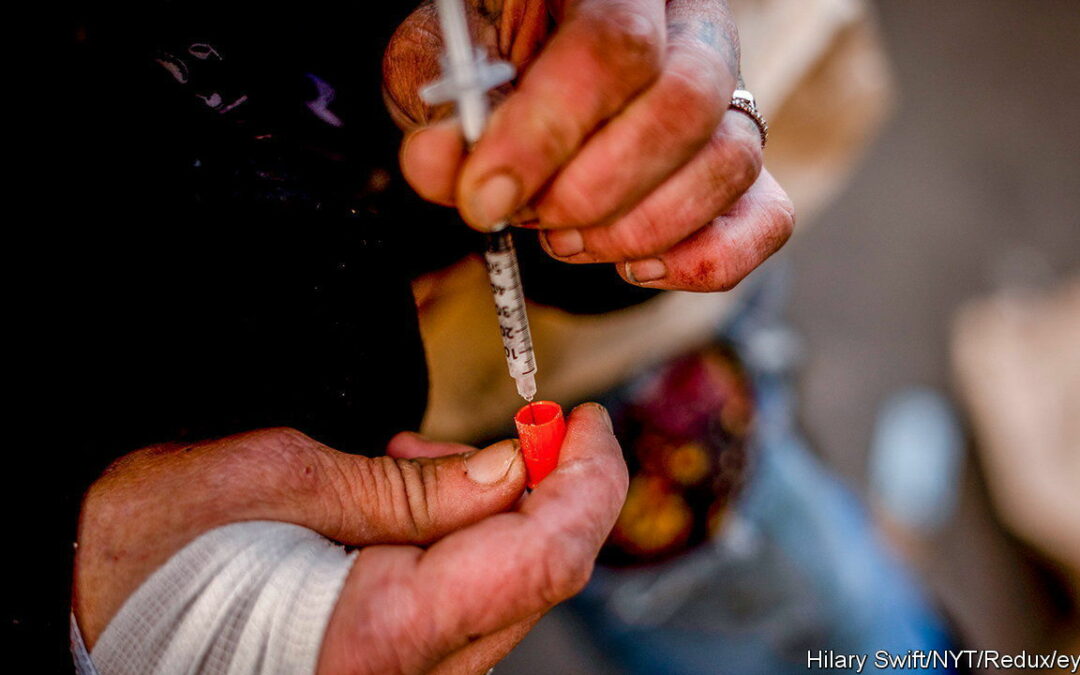IN THE EARLY 2010s reports emerged of a nightmarish drug appearing in Russia and eastern Europe. Krokodil, a cheap substitute for heroin that was concocted in kitchen laboratories, left users with scaly skin and rotting wounds. Now a similarly damaging drug, a fentanyl mix known as tranq dope, has arrived in America. Deaths associated with it have almost quadrupled since 2019, rising as a share of fentanyl-related deaths from 3% in January that year to 11% in June 2022. Last month the White House announced a plan to stop its spread. How worrying is tranq dope?
Tranq dope combines fentanyl, a synthetic opioid drug, with xylazine or “tranq”, a strong non-opioid tranquiliser used to sedate horses, deer and other large animals. It was first detected by drug authorities in the early 2000s in Puerto Rico and, in the years since, circulated there and in limited areas within the American north-east, such as Philadelphia. But the drug has now been detected in nearly every state in the country and, according to the Drug Enforcement Administration (DEA), is probably being mixed by local dealers.
Xylazine can be bought for as little as $6 per kilogram on Chinese websites, so illicit drug suppliers can maximise their profits by using it to bulk up their more expensive fentanyl, supplied mostly by Mexican drug cartels. Many end users will not know whether they are buying fentanyl or tranq dope, though it is becoming increasingly risky to assume that the former has not been cut with xylazine. In March the DEA said that almost a quarter of American fentanyl powder contained it. In 2021 the proportion was above 90% in Philadelphia.
That is cause for concern. Though chemically different from krokodil, tranq affects the body in a similar way. It too causes deep, necrotic wounds, in which skin and muscle simply rot away. Such wounds can easily become infected; ultimately limbs might need to be amputated. Large doses can cause loss of consciousness, which makes the drug-taker an easy target for assault or robbery.
Perhaps more worrying still, Naloxone, the emergency treatment for a fentanyl overdose, is ineffective against non-opioids like xylazine. Naloxone acts on opioid receptors in the brain to reverse the effects of drugs like fentanyl, in particular suppressed breathing. But for xylazine, no such antidotes are approved for humans. That means someone who has overdosed on tranq dope might need more than naloxone to survive, such as extra oxygen and breathing support.
Still, addiction medics say that synthetic opioids remain their chief concern. They kill more and more Americans every year, claiming about 70,000 lives in 2021—in comparison, about 43,000 people died in car crashes that year. Yet those taking tranq dope are at greater risk of a fatal overdose. At a minimum its growing presence complicates America’s already difficult battle against overdose deaths, and risks making drug users even more vulnerable.
Authorities seem to be taking the challenge seriously. In February the Food and Drug Administration announced that it would start checking imported xylazine, which can be legally bought for veterinary use, and detain suspicious shipments. The Biden administration’s national plan aims to reduce deaths from tranq dope by 15% in at least three of four American census areas by 2025. They hope to do this by standardising and increasing tranq testing, disrupting the illicit trade—potentially through new regulations on xylazine—and finding xylazine antidotes.
Nevertheless, the DEA suspects that tranq will continue to spread. In Puerto Rico the drug is sought out for its extended high; according to some reports, the same is now happening in Philadelphia. If more drug-users start to seek out tranq, America could have an even grimmer problem on its hands. ■









